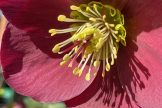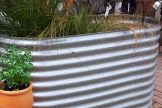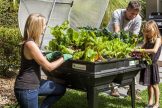
December is Garrawang in the local indigenous language. Garrawang is characterised by stormy weather, Bunjil (Eagle) is breeding, and the kangaroo apple and cherry ballart are fruiting.
Cherry ballarts (Exocarpos cupressiformis) are an interesting example of how plants have adapted to survive on Australia’s old soils. They, like quandongs must first establish a symbiotic relationship with another plant’s root system. The host plant provides nutrients and water. Cherry ballarts are beautiful small trees, however they are fiendishly difficult to propagate and therefore hard to find in nurseries. There are however many other beautiful Australian trees.
Trees are wonderful for providing food and habitat for our wildlife. In addition, they can save us money, by cooling houses down in summer and slowing chilling winds in winter. Trees have other benefits too. They can reduce the amount of run–off in a storm helping to prevent flash flooding, of course they exchange carbon dioxide for oxygen and they can make boggy sites dry.
Enjoy the Jacarandas flowering and the first of the berries fruiting. Red currants ripen at the start of December, just in time to make red currant jelly – a beautiful gift for all the friends and relations at Christmas. If you are lucky enough to own a cherry tree or two, this is their time too. Such a luxurious feeling to pick and eat your own cherries – and so delicious!

Perhaps with the arrival of some dryer, warmer weather, we can once again enjoy long summer evenings with friends and family. Now is the time to be outside and feel the sun warm up your bones. A comfy chair in the garden under a tree, a good book, a glass of wine, or the radio blaring, gloves on, bum up, whatever works for you – just enjoy the summer.
The Chinese have a proverb; “The best time to plant a tree was 20 years ago. The second best time is now”. This might be true in the northern hemisphere and for some of our native trees, however, they probably didn’t know about Silver wattle (Acacia dealbata). A great local, fast growing tree useful for providing shade in just three- four years. Although it will only last 20 years, you can grow a tree nearby to take over in the meantime. Acacia dealbata heralds the end of winter with its beautiful yellow ball flowers. Its feathery grey leaves are beautiful and soft. For more information about the advantages of trees go to our link The Advantages of Trees
If you didn’t get the chance to get your herbs in over spring, an easy substitute is an advanced pot of herbs and harvesting from it all summer long – simple and healthy, and you still get fresh herbs. Similarly with edible flowers to toss through salads, dress up plates and add that extra splash of colour – just grab some pots and use them all summer.

If you are keen to spruce up the garden for summer / Christmas entertaining, there are many options to give a lift to your existing space. For sunny spots, Brachyscome (a blue, white or pink groundcover daisy) is tough-tough-tough and will flower for months. There is also Arctotis and Osteospermums for that colourful daisy look – and of course the difficult to pronounce, but easy to grow, Argyranthemums (daisy bushes) – all of which have been bred to look fabulous for months. As well, growers are supplying stunning baskets of colour with mixed calibrachoas, petunias, dichondra silver falls, fuchsias in brilliant jewel tones, and bright lotus bertholotti, which all give an instant wow effect for people who have no time or interest in doing it themselves. If you are hand watering, now is the time to use a liquid fertiliser – potted plants will especially appreciate it.
For shade, there are many options. Some favourites are hostas and heucheras. The main advantage of this pair is that it is all about the foliage, so you are not dependent on a short flowering period. There are dozens to choose from, and the heucheras range from lime / yellow green through oranges, red and deep purples. They are easy to grow and look great all year, and get better from one year to the next. Hostas are a favourite, growing them in pots makes it easier to protect them from snails. Hostas give a cool, lush look to a space. They die back in winter, so a great idea is to under-plant them with winter flowering bulbs. Bromeliads are an option for dry shade – they thrive on neglect and can look spectacular.

Summer is also the time to go for walks and see what is doing well in other people’s gardens. Gardeners love to talk about their gardens and are complimented by inquiries and almost always willing to share information.
Edible Gardening
Look to plant more drought tolerant productive plants when the weather is warmer, or plan to include more of these in your garden. Once established they will provide you with more food for less water and attention. Try Mediterranean herbs such as oregano, marjoram, thyme and sage. Scented geraniums and savouries also need less water. The more drought tolerant fruit and vegies include artichokes, Lebanese eggplant, chillies, cherry tomatoes, Bay, olives, cane berries (such as raspberries, boysenberries, youngberries), many of the bush foods, feijoas and cherry guavas. There are also advanced tomatoes, and herbs available now if you didn’t get them in earlier.
Edibles to plant in Melbourne in December.
Below is a list of edible gardening seeds and seedlings that can be planted in December. Please keep in mind that this list has been developed for Melbourne’s climate. Some of the plants indicated will be either right at the start or the end of their ideal planting season, click the links to the factsheets for more detailed planting information.
 – Seeds – Seeds – Seedlings – Seedlings
|
 – Tubers / Crowns – Tubers / Crowns – Companion Plants – Companion Plants
|
 – Prone to Cabbage Butterfly – Prone to Cabbage Butterfly
|
Alyssum   Amaranth  Angelica  Artichokes (Globe)  Artichokes (Jerusalem)  Basil   Beans (climbing)   Beans (dwarf)   Beetroot   Borage   Burdock  Canteloupe  Capsicum  Cardamom Leaf  Carrot   Celeriac  
Celery |
Cosmos  Cress   Cucumber   Curry Plant  Daikon  Dill  Echinacea    Eggplant  Feverfew   Good Bug Mix   Horseradish  Kale   Leeks   Lemon Balm  Lettuce  Licorice Herb  Lovage   Marigold   Marjoram   Mint  Nasturtiums   Oregano   Parsley   Parsnip  Pumpkin 
|
Radish   Rhubarb  Rocket / Arugula  Rockmelon  Rosemary   Saffron Crocus (Bulbs) Sage  Salad Burnett  Savory   Silverbeet   Sorrel  Spring Onion   Squash  Sunflower  Sweet Corn   Tarragon  Tatsoi  Thyme   Tomatoes  Turnip  Warrigal Greens  Wasabi  Watercress   Watermelon  Zucchini 
|

Harvesting Your Produce
Harvest-wise, your garden should be providing a lovely assortment if you planted in early spring. Strawberries, raspberries and other cane berries, lots of salad and even some tomato varieties by Christmas. Other fruits to harvest include gooseberries, figs, cherries, early nectarines such as ‘May Grand’ or early Peaches such as ‘Anzac’, and the tail end of the Mulberries.
Succession planting
If you stagger the planting of your edible plants they will be ready at varying times, which means a longer harvest time. If you planted up big in spring, you can now successively plant vegies to keep your harvest going into autumn. Beans, corn, cucumber, carrots, baby pumpkin and zucchini can all be replanted now alongside your existing crop. You can also still plant many herbs now, but be sure to keep parsley in the semi shade. Exceptions are rocket and coriander, as they easily bolt to seed in the heat. They can still be grown now if you really love the flavour, but you will need to plant them in dappled shade or a spot that only gets some morning sun. Be sure to pick off any flower stalks. Plant more lettuce… you can never have too much salad this time of year.
Feeding & Maintenance Tasks in your Edible Garden
Remove fallen fruit off the ground to help break any pest and disease cycles; if you have chooks or ducks, they will normally do this for you. Put bands of corrugated cardboard or hessian on apple and pear trees to try to catch coddling moth pupating – check every 3 weeks and destroy any caterpillars you find. It’s a good time to put pheromone traps out for them too. Remove old gall wasp traps in your citrus as they only last for 3-4 months and will have done their job now. Remove many central tomato plant leaves and any that are shaded as they’ll only yellow off anyway. By removing them you keep a better airflow though the plant helping to keep diseases at bay. Tomatoes should be staked at planting, but do stake them if you haven’t already and tie them on to the trellis/stake with a soft tie or old bits of clothing cut into strips. Tomatoes, eggplants, capsicums and other fruit bearers will do well from another application of potash or seaweed fertiliser now to help promote and develop fruit. Finally, top dress your vegies and herbs with some organic fertiliser or keep them liquid fed regularly.
Pruning
Prune out any dead or diseased wood from deciduous and evergreen shrubs and trees. Deadhead perennials and roses. A very light prune of roses after their first spring flowering will help ensure another flush of blooms later in summer. The easiest way to do this is to cut the rose flowers to enjoy indoors in a vase – it has been claimed that you can time the next flush of flowers: prune lightly 55 days before you need them, and they should be there in time.
Thrip
Thrip begin to cause problems now as the weather warms up. Thrip are small insects that attack a wide variety of plants including fruit trees, vegetable crops, roses and other ornamental plants – they attack the flowers, fruit and foliage causing considerable damage. Leaves may appear to be finely mottled with a silvery appearance. The flowers will have brown spots on them and if attached as a bud, can be deformed. Thrip tend to feed in protected areas like under the leaves or in unopened flower buds, so control can be difficult. Systemic sprays don’t seem to work, though some success with time-released pyrethrum has been reported. You might like to experiment with sticky traps hanging from the plants (a yellow piece of cardboard, smeared with Vaseline). Here in the nursery we have released the Montdorensis predatory mite, and are about to release Orius predatory bugs. Individual households can also do this – just go to the Bugs for Bugs website to purchase on line. We no longer use insecticidal sprays in the nursery – for more information head to our factsheet on Garden Pest Control.
Cabbage White Butterflies
The cabbage grubs burrow deeply into the hearts of tender vegie plants, leaving their mess behind, and they can devour leaves in an overnight feeding frenzy. Get back at them with Dipel or Success, both of which are biological agents and rated suitable for organic farming, therefore safe for humans. They degrade with sunlight – so spray in the evening for most effective use.

Gardening With Kids
Over the school holidays, try introducing children to gardening by propagating some succulents. Most of these are very simple to do by taking cuttings or offsets. The unusual shapes and textures of these amazing plants will fascinate and inspire kids. They are also virtually indestructible and are a great way to teach kids about the variety in the plant kingdom and about biology. They also make great plants that can be kept inside on a bedroom windowsill. Bonsai plants are another living gift that capture children’s imaginations, giving them the opportunity to care for a plant or miniature garden scape and to sculpt and shape it. Children never fail to be enthralled by carnivorous plants such as the Venus Fly Traps – they might not make ideal stocking fillers, but they will be enjoyed. Cacti, again not to be stuffed into the stocking, can introduce children to gardening in a very low maintenance fashion. They come in an amazing array of shapes and colours and are great for the older child. For more information head to our factsheet on Cacti & Succulents.
Books are always a good choice, and our bookshop has loads of gardening books for children (and adults too, of course). For the well-seasoned gardening child, gloves and little critters to decorate garden pots are inexpensive and worthwhile Christmas presents. Teach the kids about how to sow seeds and propagate plants –sunflower seeds are easy to sow and quick to come up; or take cuttings of Geraniums, which will strike readily, making new plants to plant out or share. Hoping your summer holidays are healthy, happy and peaceful from all at BAAG.














